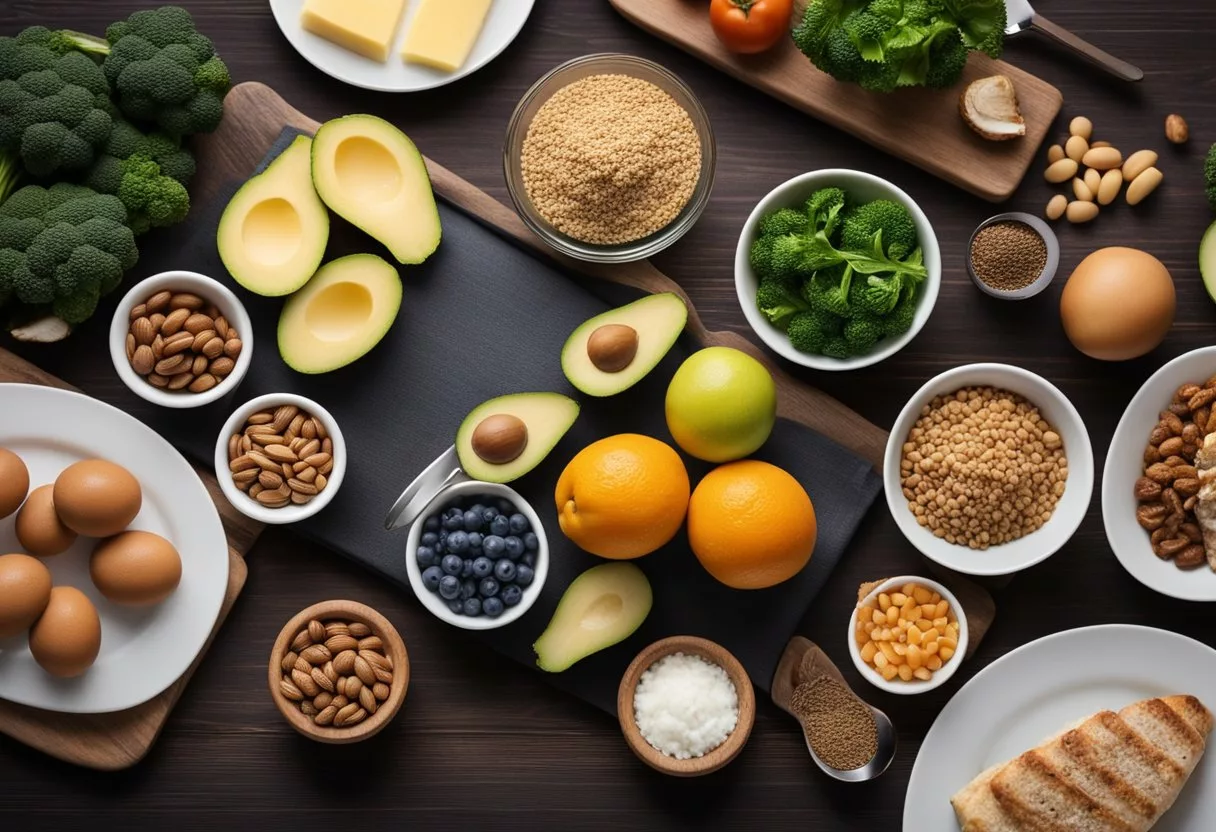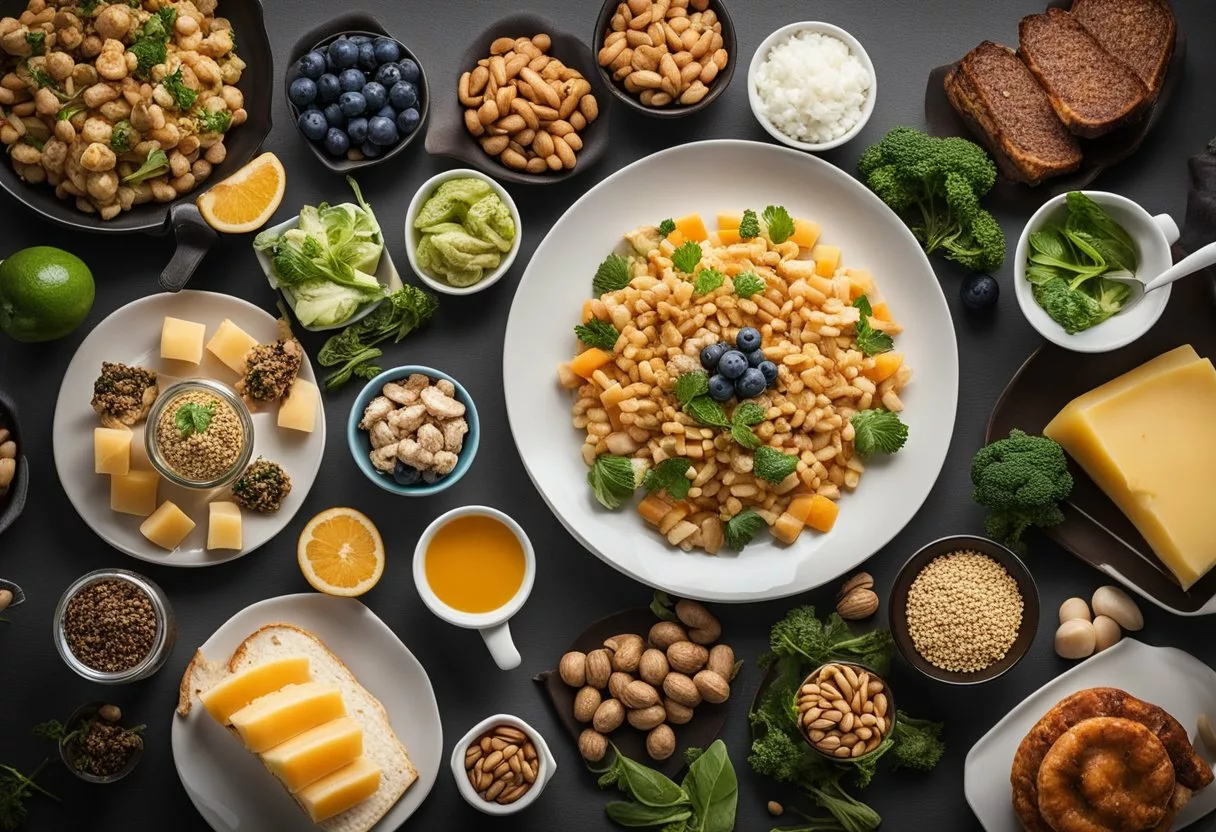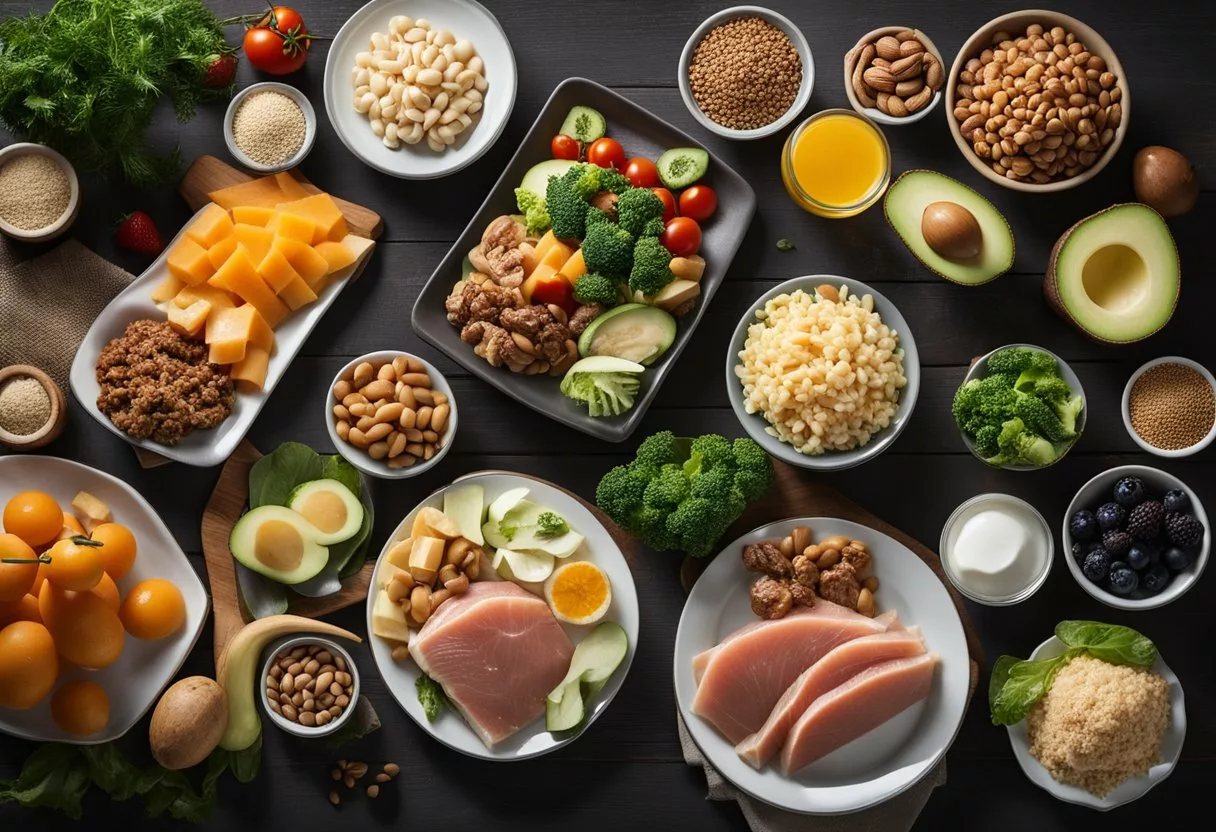Managing hunger effectively is a critical component for success on the ketogenic diet. This low-carb, high-fat dietary approach aims to induce a state of ketosis in the body, where fat is burned for fuel instead of carbohydrates. While this metabolic state can lead to weight loss and improved energy levels, initial transitions into ketosis may trigger increased hunger and cravings as the body adapts to reduced carb intake.

Individuals on a ketogenic diet can experience fluctuations in appetite, where they may feel more hungry than usual, especially during the early stages. Understanding the body’s hunger signals is essential in distinguishing between the need for nourishment and the desire to eat out of habit or for emotional reasons.
One can manage hunger by incorporating appetite-suppressing foods and drinks known to aid in satiety, like saffron, ginger, and yerba mate tea. Moreover, ensuring adequate protein consumption and staying hydrated can significantly diminish the intensity of hunger pangs.
It’s important to realize that experiencing hunger on a ketogenic diet is not uncommon and learning to manage it is part of the process. It’s not just about what you eat, but also when and how you eat that can influence hunger levels.
Strategies like meal timing, nutrient balance, and mindfulness can align with keto principles to help control appetite, making the diet sustainable in the long term. With the right approach, individuals can minimize hunger and optimize their keto diet journey for better health outcomes.
Understanding Keto Diet Basics

The ketogenic diet is a nutritional approach where the focus is on consuming more fat and fewer carbohydrates, prompting the body to switch to fat as its primary energy source.
What is Ketosis?
Ketosis is a metabolic state in which the body‘s energy supply comes from ketone bodies in the blood, in contrast to a state of glycolysis in which blood glucose provides energy. This process occurs when carbohydrate intake is drastically reduced, typically to around 20-50 grams per day, and fat consumption is significantly increased. The liver converts fat into ketones, which then serve as the main energy source for the body.
Benefits of a Ketogenic Diet
A ketogenic diet may offer several benefits, including weight loss, improved blood sugar control, and a reduction in appetite. Studies suggest that because the body is burning fat for energy, it can help reduce fat stores, leading to weight loss. Additionally, by reducing carbohydrates, the keto diet can help stabilize blood sugar levels, which may benefit individuals with diabetes.
Keto Macronutrients Breakdown
The typical macronutrient ratio for a ketogenic diet is as follows:
- Fat: 70-80% of total daily calories
- Protein: 20-25%
- Carbohydrates: 5-10%
These percentages ensure that carbohydrate intake remains low enough to maintain ketosis, protein is adequate to preserve muscle mass, and fat is sufficiently high to provide energy and support metabolic processes. It’s essential to carefully monitor and balance these macros to sustain the ketogenic state.
The Science of Hunger and Satiety
Understanding the interplay between hormones and dietary choices is critical in managing hunger and achieving satiety on a ketogenic diet.

Hunger Hormones: Ghrelin and Leptin
Ghrelin and leptin are hormones that play central roles in the regulation of hunger and appetite. Ghrelin, often termed the “hunger hormone,” is produced in the stomach and signals the brain to increase appetite when the stomach is empty. Conversely, leptin is released from fat cells and is associated with suppressing hunger. Leptin signals to the brain that there is sufficient energy storage, thus reducing the impulse to eat.
A ketogenic diet can influence the levels of these hormones. Studies indicate that adopting a ketogenic diet may reduce ghrelin’s effect, leading to a decrease in hunger sensations. Similarly, while weight loss typically raises ghrelin levels, this effect is less pronounced with ketogenic diets, suggesting an advantage for maintaining weight loss and appetite control.
Satiety and Satiated: What Makes Us Feel Full?
Satiety is the feeling of fullness and the absence of hunger after eating, which is crucial for stopping food intake and avoiding overeating. Factors contributing to satiety include the macronutrient composition of a meal, with protein and fat generally considered more satiating than carbohydrates.
The ketogenic diet, high in fats and moderate in proteins, can significantly impact one’s sense of satiety. Nutritional ketosis, a state where the body utilizes ketones for fuel, is associated with increased feelings of fullness. This could be due to ketone’s potential role in modulating the brain’s response to hunger and satiety signals. Additionally, the reduction of carbohydrate intake can lead to more stable blood glucose levels, which is believed to contribute to reduced hunger cues.
Managing Hunger Pangs on Keto

When following a ketogenic diet, an individual can encounter hunger pangs as their body adjusts to a lower carbohydrate intake. Recognizing the factors that influence these sensations and how to manage them can lead to a more comfortable and successful adherence to the keto diet.
Adjusting to Lower Carb Intake
Initially, the body responds to reduced carbohydrate consumption with feelings of hunger as it transitions from glucose to fat as its primary fuel source. To mitigate hunger pangs, one should:
- Ensure meals are balanced with adequate proteins, fats, and fibers to enhance satiety.
- Incorporate appetite-suppressing foods like ginger or yerba mate tea which may decrease the desire to eat.
Keto-Adaptation and Appetite Changes
Hunger typically subsides after the body becomes keto-adapted. This process can take several weeks, during which the body’s metabolism shifts to efficiently utilize fats. Strategies to manage hunger during this period include:
- Scheduling regular meal times to provide the body with a reliable energy source.
- Consuming sufficient fats, the cornerstone of a keto diet, to help regulate appetite and provide satiety.
Interplay Between Blood Sugar and Hunger
Fluctuations in blood sugar levels can induce feelings of hunger, even when the body has enough calories. On keto, stable blood sugar may reduce cravings and hunger pangs. Tips for maintaining even blood sugar include:
- Eating meals with a low glycemic index to avoid blood sugar spikes.
- Snacking on high-fat, low-carb options like nuts or cheese to keep blood sugar levels stable between meals.
Nutritional Strategies for Sustained Fullness

When following a ketogenic diet, strategic macronutrient distribution combined with adequate fiber and water intake is essential for managing hunger and ensuring fullness. Incorporating nutrient-dense keto foods can help provide the necessary vitamins and minerals while keeping calorie count in check.
Macronutrients Impact on Hunger
The three macronutrients—fats, proteins, and carbohydrates—each play a unique role in satiety and hunger management. On a ketogenic diet, one should aim for a high intake of healthy fats, which are energy-dense and slow to digest, thus providing longer-lasting fullness. Protein intake is also crucial as it can reduce the levels of ghrelin, the hunger hormone, while boosting the satiety hormones. It is recommended to distribute protein intake evenly throughout the day to maximize these effects.
The Role of Fiber and Water Intake
Fiber, although not a direct source of energy, contributes to fullness by adding bulk to the diet and slowing digestion. High-fiber, low-carb vegetables should be included in the meal plan. Adequate hydration also plays a role in satiety, as water can fill stomach volume and trigger receptors that signal fullness to the brain. Thus, it is beneficial to stay well-hydrated throughout the day.
- Daily Water Intake Recommendation: Aim for at least 8 glasses or approximately 2 liters.
- Fiber Goal: Target around 25 grams of fiber per day from low-carb sources.
Incorporating Nutrient-Dense Keto Foods
Nutrient-dense keto foods provide essential nutrients without excess calories. These include leafy greens, cruciferous vegetables, avocados, nuts, seeds, and lean meats. They contribute not only to fullness but also to the overall nutritional quality of the diet. Consumption of these foods also leads to the production of ketones, which can have a natural appetite-suppressing effect.
- Keto Food List:
- Avocados: High in fat and fiber, perfect for keto.
- Leafy Greens: Low in carbs, high in fiber.
- Nuts and Seeds: Good sources of fats and moderate protein.
- Lean Meats: Provide satiating protein without excess fat.
Meal Planning and Eating Habits
Effective management of hunger on a ketogenic diet hinges on strategic meal planning and establishing consistent eating habits. This section addresses how to create a balanced keto meal plan, the significance of adhering to regular eating schedules, and methods for practicing mindful eating and portion control to mitigate cravings and prevent overeating.
Creating a Balanced Keto Meal Plan
A well-structured keto meal plan balances macronutrients—fats, proteins, and low net carbs—to maintain ketosis without leading to hunger. An ideal plan includes:
- 50 grams of net carbs or fewer per day: Focus on fiber-rich vegetables to maintain fullness.
- Adequate protein: Opt for lean meat choices that satisfy without exceeding protein needs.
- Healthy fats: Prefer unsaturated fats over saturated ones to support heart health.
A sample daily meal plan might look like this:
| Meal | Foods |
|---|---|
| Breakfast | Scrambled eggs with spinach and avocado |
| Lunch | Grilled chicken salad with olive oil dressing |
| Dinner | Salmon with asparagus and a side of cauliflower rice |
| Snacks | Cheese cubes, nuts, or olives |
Importance of Regular Eating Schedules
They maintain a regular eating schedule to prevent extreme hunger and reduce snacking tendencies. Eating at consistent times helps regulate the body’s metabolic response and can align with intermittent fasting if meals are planned within a specific eating window.
- Breakfast: Start the day with a protein-rich meal.
- Lunch and Dinner: Space these to avoid long gaps that might lead to cravings.
- Intermittent Fasting: For those who opt for intermittent fasting, planning meals within an 8-hour window, like from 12 PM to 8 PM, may enhance the benefits.
Mindful Eating and Portion Control
Mindful eating involves paying full attention to the eating experience, savoring each bite, and listening to body signals to detect satiety. They adopt this approach to reduce emotional eating and regulate food intake. Portion control is crucial; they use smaller plates or bowls to naturally limit portions and avoid overeating. Instead of large meals, eating smaller, more frequent meals can help to keep energy levels stable and hunger at bay. They can include:
- Protein-rich snacks: These can help feel fuller for longer and thwart the temptation for high-carb options.
- Volume eating: Incorporate salads and soups that are high in volume but low in calories to aid in feeling full.
Keto-Friendly Foods That Curb Hunger
To effectively manage hunger on a keto diet, one must focus on incorporating foods that are rich in quality fats, proteins, and fiber. These nutrients are essential for satiety and can help reduce cravings.
Understanding Fats: MCT Oil and High-Fat Choices
Fats are a cornerstone of the ketogenic diet and selecting the right types is crucial for curbing hunger. MCT oil is a unique fat that is metabolized differently from other types. It’s absorbed quickly and can supply a rapid form of energy, similarly to carbohydrates but without causing a spike and crash in blood sugar. Incorporating MCT oil into a ketogenic diet might help reduce feelings of hunger. High-fat choices such as avocado, olive oil, and nuts are not only nutrient-dense but also contain fats that can keep you feeling fuller for longer.
- Fats to include:
- MCT Oil
- Olive Oil
- Avocados
- Nuts (almonds, walnuts, macadamias)
Protein-Rich Foods to Enhance Satiety
Protein is an essential macronutrient that plays a key role in satiety. On a keto diet, one should seek out foods that provide adequate protein to keep hunger at bay. Eggs are a perfect example of a keto-friendly protein source—they’re versatile, full of nutrients, and can be cooked in various ways to keep meals interesting. Additionally, lean meats, fatty fish, and a moderate intake of cheese offer substantial amounts of protein that contribute to fullness.
- Protein sources for keto:
- Eggs
- Chicken
- Beef
- Fatty fish (salmon, mackerel)
Low-Carb Vegetables and Their Benefits
Vegetables are vital for a well-rounded ketogenic diet due to their fiber content and nutritional profile, which support digestion and can help curb appetite. Low-carb vegetables like spinach, kale, and broccoli are low in calories yet high in fiber, which is beneficial for staying full longer and managing cravings.
- Low-carb vegetables to consume:
- Spinach
- Kale
- Broccoli
- Cauliflower
By choosing the right balance of keto-friendly foods that support satiety, individuals can more effectively manage hunger and adhere to their ketogenic lifestyle.
Lifestyle Factors Influencing Hunger
In managing hunger on a ketogenic diet, one must consider various lifestyle factors that can significantly impact appetite. Sleep, exercise, and hydration play pivotal roles in how the body processes hunger signals and manages weight loss.
The Impact of Sleep on Hunger and Weight Loss
Sleep is fundamental to regulating hormones that control hunger, such as ghrelin and leptin. Sleep deprivation can increase ghrelin, the hunger hormone, while decreasing leptin, the hormone that signals fullness. Consequently, individuals may experience an increase in appetite and cravings, which can hinder weight loss efforts. A consistent sleep schedule supports better energy levels and can facilitate efficient fat burning.
Exercise’s Role in Appetite Suppression
Regular exercise contributes to stabilizing blood sugar and energy levels throughout the day, which can help suppress untimely hunger pangs. Exercise, especially strength training, is instrumental in increasing muscle mass, which can boost metabolism and aid in burning body fat. Importantly, the type and intensity of exercise can vary in their effects on appetite, with some forms leading to increased hunger, while others may temporarily suppress it.
Hydration and Distinguishing Thirst from Hunger
Hydration is often overlooked in hunger management. Many people confuse thirst for hunger, leading to unnecessary snacking when the body actually needs water. Adequate hydration can aid in distinguishing true hunger from thirst. Furthermore, staying hydrated optimizes metabolic function and supports energy levels, which is key for those aiming for weight loss on a ketogenic diet. It’s crucial to drink ample fluids and recognize the body’s hydration cues.
Addressing Challenges and Common Issues
When adopting the ketogenic diet, individuals often face several hurdles. Understanding how to navigate issues like the keto flu, cravings for sugar and high-carb foods, and emotional eating can determine long-term success on the diet.
Coping with Keto Flu and Carb Withdrawal
The keto flu is a term given to a collection of symptoms that people may experience when they first start a ketogenic diet. These symptoms include fatigue, headaches, and irritability, thought to be caused by the body’s withdrawal from carbohydrates and transition into ketosis. To mitigate these effects, one strategy is to:
- Increase electrolyte intake: Ensuring adequate levels of sodium, magnesium, and potassium can help alleviate symptoms.
It’s also important to gradually reduce carbohydrate intake rather than cutting carbs suddenly, which can ease the body into ketone production without severe carb withdrawal symptoms.
Handling Sugar and High-Carb Cravings
Cravings for sugar and high-carb foods are common on a keto diet, especially initially. Such cravings can often lead to individuals deviating from their diet. To combat this:
- Find keto-friendly alternatives: Satisfy your sweet tooth with snacks that fit the keto macronutrient profile.
- Plan meals: Ensure meals are balanced and filling to reduce the likelihood of cravings.
Curbing these cravings is a matter of consistent dietary habits and recognizing that high-carb diet indulgences are counterproductive to achieving ketosis.
Strategies for Emotional Eating and Stress
Emotional eating can sabotage a ketogenic diet, especially when stress triggers the desire for comfort foods that are often high in carbohydrates. To manage emotional eating:
- Practice mindfulness: Taking a moment to assess true hunger levels may prevent unnecessary snacking.
- Identify and address the root cause of stress: Strategies like meditation or physical activity can decrease the release of cortisol, a stress-related hormone that can affect mood and hunger levels.
Understanding the psychological factors tied to eating habits can lead to better dietary choices and improved management of emotional triggers that lead to food cravings.
Supplements and Additional Aids
When managing hunger on a ketogenic diet, certain supplements can help maintain nutritional balance and enhance ketone production. Here’s how you can optimize your keto experience using targeted supplementation.
Vitamins and Minerals
The ketogenic diet, while effective for weight loss, can sometimes lead to a deficiency in specific vitamins and minerals. It’s essential for individuals to ensure they are getting a well-rounded intake of nutrients. Key vitamins and minerals that should be monitored include:
- Electrolytes: Sodium, potassium, and magnesium are crucial for hydration and may need to be supplemented.
- Calcium: Important for bone health, especially if dairy intake is reduced.
- Vitamin D: Often paired with calcium for bone health and can also support immune function.
- B-Complex Vitamins: Especially important as they are involved in energy metabolism.
A tailored multivitamin designed for low-carb diets can be helpful in covering these nutritional needs. However, individuals should seek nutrient-dense keto-friendly food sources first before turning to pill-based supplements.
Ketone Supplements and Their Uses
Ketone supplements, such as BHB (Beta-Hydroxybutyrate), can be used to enhance endogenous ketone production, which may help individuals achieve ketosis more readily.
- Exogenous Ketones: These supplements provide ketones directly and can temporarily boost ketone levels in the blood, aiding in reducing hunger and cravings.
- MCT Oil: Converts to ketones more easily, providing a quick source of energy and potentially helping to keep hunger at bay.
These supplements are valuable additions for individuals looking to manage hunger and support their metabolic state on a ketogenic diet. They should be used in conjunction with a proper keto diet plan and not as a replacement for healthy eating habits.
Long-Term Success on Keto
Success on a ketogenic diet hinges on maintaining ketosis through a high-fat, moderate-protein, and low-carbohydrate plan. Managing hunger and sustaining weight loss are pivotal for long-term adherence and health benefits, including mental clarity.
Sustainable Keto Dieting and Lifestyle Changes
Sustainable keto dieting requires a strategic approach to fat consumption and lifestyle adaptations. Individuals should focus on consuming sufficient healthy fats to feel satiated and maintain ketosis. To keep hunger at bay, it is crucial to:
- Prioritize whole, unprocessed foods: Choose high-quality fats and proteins.
- Stay hydrated: Drink water throughout the day to help manage hunger.
- Exercise regularly: Physical activity can increase satiety and support body composition.
- Avoid artificial sweeteners: These can trigger cravings and disrupt ketosis.
- Improve sleep habits: Adequate sleep helps to regulate appetite and reduces cravings.
Monitoring Success and Adjusting as Needed
Long-term keto success involves vigilant monitoring and adapting the diet as the body evolves. Individuals should track their progress through:
- Body measurements and weight: To assess changes in body composition.
- Ketone levels: To ensure they remain in a state of ketosis.
- Hunger levels: To fine-tune caloric and macronutrient intake.
When cravings or plateaus occur, adjustments to macronutrient ratios or calorie intake might be necessary. The ability to adjust the diet in response to physical and mental feedback is key to sustaining the ketogenic lifestyle. Monitoring mental clarity and overall well-being are also essential markers of long-term dietary success.
Frequently Asked Questions
Managing hunger is a common challenge in the ketogenic diet. The FAQs below provide direct answers focused on maintaining satiety and nutritional balance.
What foods can be eaten in abundance on a ketogenic diet?
On a ketogenic diet, individuals can eat foods high in fats and low in carbohydrates like leafy greens, fatty fish, meats, cheese, nuts, and seeds in abundance. These foods contribute to feelings of fullness and align with the macronutrient ratios required for ketosis.
What are the top foods to include in a keto meal plan for satiety?
To enhance satiety, one should prioritize the inclusion of avocados, eggs, coconut oil, full-fat dairy products, and fibrous vegetables such as broccoli or Brussels sprouts. These choices are nutrient-dense and help satiate while minimizing carb intake.
How can you combat feelings of fatigue and persistent hunger on keto?
Combating fatigue and hunger involves ensuring adequate hydration, consuming balanced meals rich in healthy fats and proteins, and potentially supplementing with magnesium, sodium, and potassium which could be depleted when one is on a ketogenic diet.
Is it advisable to eat on a keto diet even when you’re not experiencing hunger?
It is advisable to eat to maintain energy levels, but one should listen to their body’s hunger cues. Keto diets naturally suppress appetite due to ketone production; however, prolonged caloric deficit may require professional advice for optimal health.
How can one avoid entering ‘starvation mode’ while following a keto diet?
To avoid ‘starvation mode,’ individuals should eat enough calories to sustain their basal metabolic rate. Consuming a balanced amount of fat and protein is essential to preserve muscle mass and maintain metabolism while in ketosis.
What strategies are recommended for dealing with persistent hunger while maintaining ketosis?
Strategies include eating more frequent, smaller meals, ensuring meals are rich in protein and healthy fats, incorporating a variety of fibrous vegetables to increase volume without significant carb intake, and possibly adjusting the macronutrient balance to slightly increase the proportion of protein or fat.
